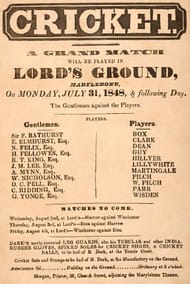Be it the rules or opinions, cricket has always been a batsmen’s game. The term “Gentleman’s game” has two completely different meanings. One being the obvious: that cricket is usually played with great sportsmanship. The second simply reiterates the fact that batsmen have an edge over the game. To understand this better, let’s go back to early 19th century England.
Origin of the “gentleman's game”
This era saw the rise of club-level cricket. There were two teams, namely The Gentlemen/Amateurs and The Players/Professionals. The difference between the teams was based on the English economic class structure.
The Gentlemen usually consisted of well-off men who played more for “pride” (although there are some unresolved speculations that they were paid more) and the Professionals consisted men of the working class who “played for money”.
Even before this setup, the same division existed within the team. But more often than not, the gentlemen were usually batsmen and the professionals were bowlers. And usually, the captain was always one of the Gentlemen. And these gentlemen had more influence in shaping the rules of the game, owing to their better economic status and social influence.
The two teams were abolished by the MCC in 1963 and since then, every first-class cricketer was considered a professional. But the effects remain deep in the roots of the modern game.
Present-day scenario
More often than not, batsmen make captains even if there are more experienced bowlers in the team. The rules continue to favour the batsmen. And the controversies around the Test series between India and South Africa show that public opinions support batsmen too.
The Nagpur Test has sprouted many controversies ranging from whether India took too much liberty to use the home advantage to whether the pitch was below the standards of international cricket.
The people shunning the wicket have their reasons as well. In a time where scoring 300 is normal and double centuries have been made possible in 50-over cricket, the highest team score of the test was 215 and the top score was a meagre 40, which is the second lowest top score in a test match since 1890.
The pitch was slow, low and spinning square and the game was done and dusted in under three days. That the pitch was unplayable for batsmen, was the accusation. And that has also been ICC’s conclusion.
Meanwhile, Down Under and 10 days before the end of this infamous Test, the second Test match between Australia and New Zealand ended in a mind-numbing draw in Perth.
A track as flat as the pitch of a rapper, saw just 2272 runs in 5 days. There were just 4 centuries and 2 double centuries, both higher than the highest team score in Nagpur. While the retirement of Mitchell Johnson took some of the attention away from the ridiculous statistics, I am sure that this pitch wouldn’t have grabbed as much attention as Nagpur anyway.
That the pitch was unplayable for bowlers, was never given much of a thought. Just a sympathetic sigh, nothing more.
When the lead character of a film gets beaten up by a group of huge men, it is usually seen as sad and pathetic. But when the comedian of a film gets beaten up exactly the same way, most of us are entertained.
Spinners holding the collar of batsmen and dragging them around all day long is pathetic but those big heavy bats coming down on bowlers and crushing them like ants stuck under your feet, is not that bad.
I am in no way justifying the former. Both the situations are equally bad but the comparative treatments are completely unacceptable. The Perth wicket was as flat as the road in any race course and the Nagpur wicket, as dusty as the road across my street.
Finding the balance
The wicket in Delhi can be considered decent with conditions helping. It had something for everyone. Rahane scored twin centuries, Abbott scalped 5 wickets in the first innings, Morkel and Yadav took 3 in the second, Piedt took 4 and Jadeja and Ashwin dismissed 7 batsmen each in the match. And not to forget, South Africa crawled through 143 overs in the last innings, which is a phenomenal effort.
A good wicket is one that has something for everyone. A team has players apart from the spinners and the top order. Tracks like the one in Delhi and the one in Adelaide had something for everyone.
The ICC really needs to crack down on the double standards against bowlers (especially spinners) in the game. It needs to be made clear that a flat belter is as poor as a damp/dusty square turner.
Also, if having a quick, bouncy wicket against a sub-continental team in Australia is not questioned, then India has all the right to use their home advantage to the fullest and provide slower tracks.
But this hampers competition as visitors are more often left waiting to be mauled by the home team. Therefore, it is best that the ICC intervene and prevent the home teams from dictating the type of pitch to be prepared. It is definitely a lesser burden to the boards and the curators if the latter are given more liberty to prepare a pitch of their choice, keeping in mind the quality standards to be maintained.
Follow IPL Auction 2025 Live Updates, News & Biddings at Sportskeeda. Get the fastest updates on Mega-Auction and cricket news




